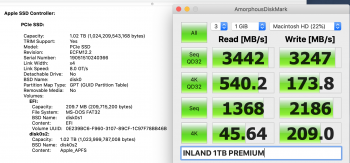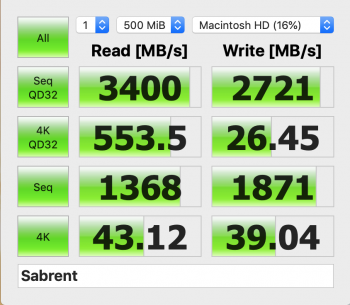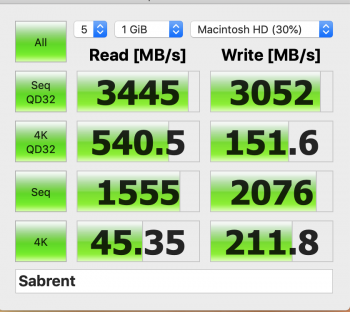From the excellent comparison test conducted by
@gilles_polysoft on the page 1 header of this thread, the 512GB Sabrent Rocket demonstrated the same characteristic you observed with the 2TB SSD. While is unusual for an SSD to write faster than it reads, this appears to be consistent behavior resulting from Sabrent design choices; it doesn't seem that you made any installation errors:
View attachment 842426
Right now, the choices in 2TB are limited. If you want capacity > 1TB, you may just have to "suffer" with 2300MB/s unless you're willing to spend more $ and try a different brand.
[doublepost=1560321933][/doublepost]One more thing, Allistah... unless you are doing heavy multi-user server duties with your MacBook Pro, you probably won't ever get anywhere near a queue depth of 32 for reads or writes. QD32 inflates the benchmark numbers, but much more realistic "workstation" use-case results are obtained with a queue depth of 4 for both reads and writes (the setting is in the menu options).
Attached are two runs from a Mac Pro 5,1 (link speed 5.0GT/s, PCIe slot 2 on a generic 4-lane M.2 adapter card, OSX 10.13.6) with a Sabrent 2TB (fw12.2) SSD at QD4 r/w. The first used an HFS+J format, the second used APFS. Note:
1. Slower but balanced sequential r/w performance was evident (yes, QD4 throughput is bus-limited and the results with an 8.0GT/s bus may not be as balanced. That said, on an 8.0GT/s bus QD4 numbers should still be significantly lower than QD32 numbers).
2. 4K writes with NVMe and either format were an order of magnitude faster than writes on AHCI SSDs. Latency is a big deal, especially on real-world use-cases.
3. 4K write performance was 2.3-2.4x faster with HFS than APFS. I know APFS brings modern technological improvements to Mac disk usage, but I'm _at least_ keeping a small partition formatted HFS+ as a scratch drive for database writes, interpreted code languages. etc.
View attachment 842434 View attachment 842435







